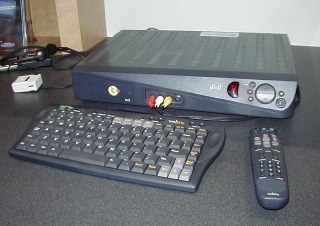Related Research Articles

Streaming media is multimedia that is delivered and consumed in a continuous manner from a source, with little or no intermediate storage in network elements. Streaming refers to the delivery method of content, rather than the content itself.

MSN TV was a web access product consisting of a thin client device that used a television for display, and the online service that supported it. The original WebTV device design and service were developed by WebTV Networks, Inc., a company started in 1995. The WebTV product was announced in July 1996 and later released on September 18, 1996. In April 1997, the company was purchased by Microsoft Corporation and in July 2001, was rebranded to MSN TV and absorbed into MSN.
A digital video recorder (DVR) is an electronic device that records video in a digital format to a disk drive, USB flash drive, SD memory card, SSD or other local or networked mass storage device. The term includes set-top boxes with direct to disk recording, portable media players and TV gateways with recording capability, and digital camcorders. Personal computers are often connected to video capture devices and used as DVRs; in such cases the application software used to record video is an integral part of the DVR. Many DVRs are classified as consumer electronic devices; such devices may alternatively be referred to as personal video recorders (PVRs), particularly in Canada. Similar small devices with built-in displays and SSD support may be used for professional film or video production, as these recorders often do not have the limitations that built-in recorders in cameras have, offering wider codec support, the removal of recording time limitations and higher bitrates.

Akamai Technologies, Inc. is an American content delivery network (CDN), cybersecurity, and cloud service company, providing web and Internet security services. The company operates a network of servers worldwide and rents the capacity of the servers to customers wanting to increase the efficiency of their websites by using Akamai owned servers located near the user. When a user navigates to the URL of an Akamai customer, their browser is directed by Akamai's domain name system to a proximal edge server that can serve the requested content. Akamai's mapping system assigns each user to a proximal edge server using sophisticated algorithms such as stable matching and consistent hashing, enabling more reliable and faster web downloads. Further, Akamai implements DDoS mitigation and other security services in its edge server platform.
In-Q-Tel (IQT), formerly Peleus and In-Q-It, is an American not-for-profit venture capital firm based in Arlington, Virginia. It invests in high-tech companies to keep the Central Intelligence Agency, and other intelligence agencies, equipped with the latest in information technology in support of United States intelligence capability. The name "In-Q-Tel" is an intentional reference to Q, the fictional inventor who supplies technology to James Bond.

Internet Protocol television (IPTV) is the delivery of television content over Internet Protocol (IP) networks. This is in contrast to delivery through traditional terrestrial, satellite, and cable television formats. Unlike downloaded media, IPTV offers the ability to stream the source media continuously. As a result, a client media player can begin playing the content almost immediately. This is known as streaming media.

Web conferencing is used as an umbrella term for various types of online conferencing and collaborative services including webinars, webcasts, and web meetings. Sometimes it may be used also in the more narrow sense of the peer-level web meeting context, in an attempt to disambiguate it from the other types known as collaborative sessions. The terminology related to these technologies is exact and agreed relying on the standards for web conferencing but specific organizations practices in usage exist to provide also term usage reference.

Skype for Business Server is real-time communications server software that provides the infrastructure for enterprise instant messaging, presence, VoIP, ad hoc and structured conferences and PSTN connectivity through a third-party gateway or SIP trunk. These features are available within an organization, between organizations and with external users on the public internet or standard phones.

Skype for Business is an enterprise software application for instant messaging and videotelephony developed by Microsoft as part of the Microsoft Office suite. It is designed for use with the on-premises Skype for Business Server software, and a software as a service version offered as part of Microsoft 365. It supports text, audio, and video chat, and integrates with Microsoft Office components such as Exchange and SharePoint.

Radvision was a provider of video conferencing solution and enabling products for IP communication developers based in Tel Aviv, Israel. Radvision was acquired by Avaya in June 2012. Spirent Communications acquired Radvision's Technology Business Unit from Avaya in July 2014, to become Spirent Developer Tools Business Unit.

Poly, formerly Polycom, a part of HP Inc., is an American multinational corporation that develops video, voice and content collaboration and communication technology.
A media server is a computer appliance or an application software that stores digital media and makes it available over a network.
Adobe Media Server (AMS) is a proprietary data and media server from Adobe Systems. This server works with the Flash Player and HTML5 runtime to create media driven, multiuser RIAs. The server uses ActionScript 1, an ECMAScript based scripting language, for server-side logic. Prior to version 2, it was known as Flash Communication Server. Prior to version 5, it was known as Flash Media Server. In February 2019, Adobe Systems Incorporated granted Veriskope Inc rights to further develop, resell, and extend distribution of the software product.
Cumulus is a digital asset management software designed for client/server system which is developed by Canto Software. The product makes use of metadata for indexing, organizing, and searching.
TelVue Corporation is a digital media company that develops broadcast solutions for multiple platforms including television, over-the-top content, Internet streaming, and mobile devices. TelVue has deployed broadcast systems and cloud-based services to media companies, professional broadcasters, and a network of municipally owned public, educational, and government access (PEG) cable TV channels. In addition, TelVue provides systems and services to colleges, universities and K-12 institutions. TelVue Corporation is a 100% employee-owned company.

Video Share is an IP Multimedia System (IMS) enabled service for mobile networks that allows users engaged in a circuit switch voice call to add a unidirectional video streaming session over the packet network during the voice call. Any of the parties on the voice call can initiate a video streaming session. There can be multiple video streaming sessions during a voice call, and each of these streaming sessions can be initiated by any of the parties on the voice call. The video source can either be the camera on the phone or a pre-recorded video clip.
Elemental was an American software company based in Portland, Oregon, and active from 2006 to 2015. It was founded by three engineers formerly of the semiconductor company Pixel works: Sam Blackman (CEO), Jesse Rosenzweig (CTO), and Brian Lewis. In 2015, it was acquired by Amazon.
Wowza Streaming Engine is a unified streaming media server software developed by Wowza. The server is used for streaming of live and on-demand video, audio, and rich Internet applications over IP networks to desktop, laptop, and tablet computers, mobile devices, IPTV set-top boxes, internet-connected TV sets, game consoles, and other network-connected devices. The server is a Java application deployable on most operating systems.
InSoft Inc. was an American developer of network-based communications software and multimedia software founded in 1992 in Mechanicsburg, Pennsylvania. The company’s applications included Communique, which is used for desktop collaboration and videoconferencing.
References
- ↑ "RioPort Appoints Starlight Founder James E. Long as President and CEO". 18 April 2000.
- ↑ "Digital Hollywood Conference 2007". Archived from the original on 2012-05-10. Retrieved 2012-06-22.
- ↑ "Video Servers in the Spotlight".
- ↑ "Full Stream Ahead".
- ↑ "CompCon Spring 1993-StarWorks-a video applications server".
- ↑ "Multimedia Project, Video on Networks".
- ↑ "Digital Hollywood Conference 2001". Archived from the original on 2012-07-28. Retrieved 2012-07-20.
- ↑ "Starlight InterMedia Networking home page". Archived from the original on 1996-12-27.
{{cite web}}: CS1 maint: bot: original URL status unknown (link) - ↑ "Starlight Networks and Hughes Network Systems". Archived from the original on 2019-04-02. Retrieved 2012-06-22.
- ↑ "Starlight Networks Introduces StarLive! -- Intranet Streaming Media Application for Enterprise Communications". Archived from the original on 2018-11-18. Retrieved 2014-12-31.
- ↑ "Online broadcasting". Forbes .
- ↑ "Starlight Networks Creates Video Solutions for GE Information Services".
- ↑ "Starlight Picturetel web page". Archived from the original on 1998-12-06.
{{cite web}}: CS1 maint: bot: original URL status unknown (link) - ↑ "PictureTel to buy Starlight Networks".
- ↑ "Q&A with Andrew Stehling, eVideo Government Sales at PictureTel". 7 March 2000.
- ↑ "AxessPoint Acquires Starlight Networks From PictureTel". 16 October 2000.